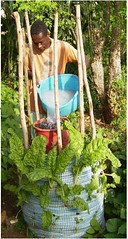| Greywater towers in Arba Minch, Ethiopia (Photo credit: Sustainable sanitation) |
Basic Components
* The tank or sump
Similar to a septic tank, the sump or tank that catches the greywater is underground. Sinks, washing machines, showers, etc. are routed into the tank. Some states and counties require that washing machines connected to greywater systems have a 3-way valve to route the water to the sewer or septic tank if needed. This is in case diapers or items contaminated by an ill person are washed in the machine.
You can choose which kinds of water you want routed into your system - if you wash a lot of diapers, for instance, you may choose not to route that water into your greywater system at all. Or you may choose only water from your kitchen sink. Depending on the number of people living in the house and the overall usage, the greywater from one sink can be significant.
* The filter
The greywater needs to be purified or treated, and most systems do this by filtering the water through sand or soil. An amazing amount of purification can be achieved through soil alone.
* The pump
Depending on the slope of your property, you may need a pump to convey the water from one part of the system to another, usually from the filter to the leach field. Most greywater systems simply rely on gravity to move the water through the system.
* The leach field
Once clean, the greywater goes into a leach field, or an area where it can be reabsorbed into the earth. You can plant a garden or crops directly over the leach field and the plants will absorb the greywater as it comes into the leach area.
| Greywater recycling (Photo credit: Wikipedia) |
There are other options for reusing greywater, depending on the kind of system and the homeowner's needs. Here are some of the more common uses. (Note - see picture to the left - I love this idea! Water from the sink fills the toilet tank which is then used to flush - great innovation!)
- Increasing groundwater
Putting the greywater back into the ground once it's clean increases the groundwater. This is a significant benefit in areas where water is scarce.
- Flushing toilets
Some greywater systems skip the leach field and provide the homeowner with extra water he or she can use in various ways, one of which is to flush household toilets. This has the potential to save quite a bit of water for the homeowner.
- Watering crops or plants
Plants need quite a bit of water, and gardens and crops and lawns need even more. Plants thrive on greywater, which does not have any of the chemicals found in treated city water, and this is a very common and effective way to use greywater, and reduce your water bills at the same time.
Be sure to check with your local officials to find out about permits, environmental concerns, etc. before proceeding with your own greywater disposal system.
Learn More About Greywater Systems:



No comments:
Post a Comment